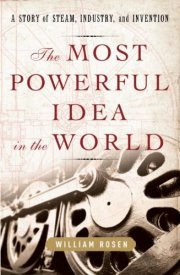Translating deep thinking into common sense
The Most Powerful Idea in the World

By Dale B. Halling
November 9, 2014
SUBSCRIBE TO SAVVY STREET (It's Free)
The Most Powerful Idea in the World: A Story of Steam, Industry, and Invention, by William Rosen, asks and answers the question—What is the most powerful idea in the world? But this is no dry academic book. Rosen is a wonderful writer and entertains the reader with the history of the beginning of the Industrial Revolution in Great Britain.
 The book explains that there are over two hundred theories for why the Industrial Revolution occurred. The author points out that most of these theories miss the most obvious point, “which is that the Industrial Revolution was, first and foremost, a revolution in invention.” Rosen elaborates thus: “For a thousand centuries, the equation that represented humanity’s rate of invention could be plotted on an X-Y graph as a pretty straight line. Then during a few decades of the eighteenth and nineteenth centuries, in an island nation with no special geographic resources it changed.” Ultimately, the Industrial Revolution was a perpetual innovation machine.
The book explains that there are over two hundred theories for why the Industrial Revolution occurred. The author points out that most of these theories miss the most obvious point, “which is that the Industrial Revolution was, first and foremost, a revolution in invention.” Rosen elaborates thus: “For a thousand centuries, the equation that represented humanity’s rate of invention could be plotted on an X-Y graph as a pretty straight line. Then during a few decades of the eighteenth and nineteenth centuries, in an island nation with no special geographic resources it changed.” Ultimately, the Industrial Revolution was a perpetual innovation machine.
England’s patent laws democratized invention by providing property rights to inventors. The protection of intellectual property allowed anyone, aristocrat or commoner, who could invent, to invent and reap the benefits of inventing. The U.S. further perfected the patent system and countries from around the world created patent systems that were nearly identical and they began the rise out of the Malthusian Trap. However, Great Britain and the U.S. led the way. This, combined with the advent of limited-liability companies and the new capital markets, resulted in an explosion of new inventions that created unimaginable wealth. Says Rosen,
The book traces and examines the history of patent law, the history of the science of steam (thermodynamics), as well as the history of the technology and economics of steam engines. The writing style is easy to read and very informative and makes a very persuasive case for legal protection of intellectual property in inventions as being the central engine of growth.
I highly recommend this wonderful, entertaining, and informative book.








